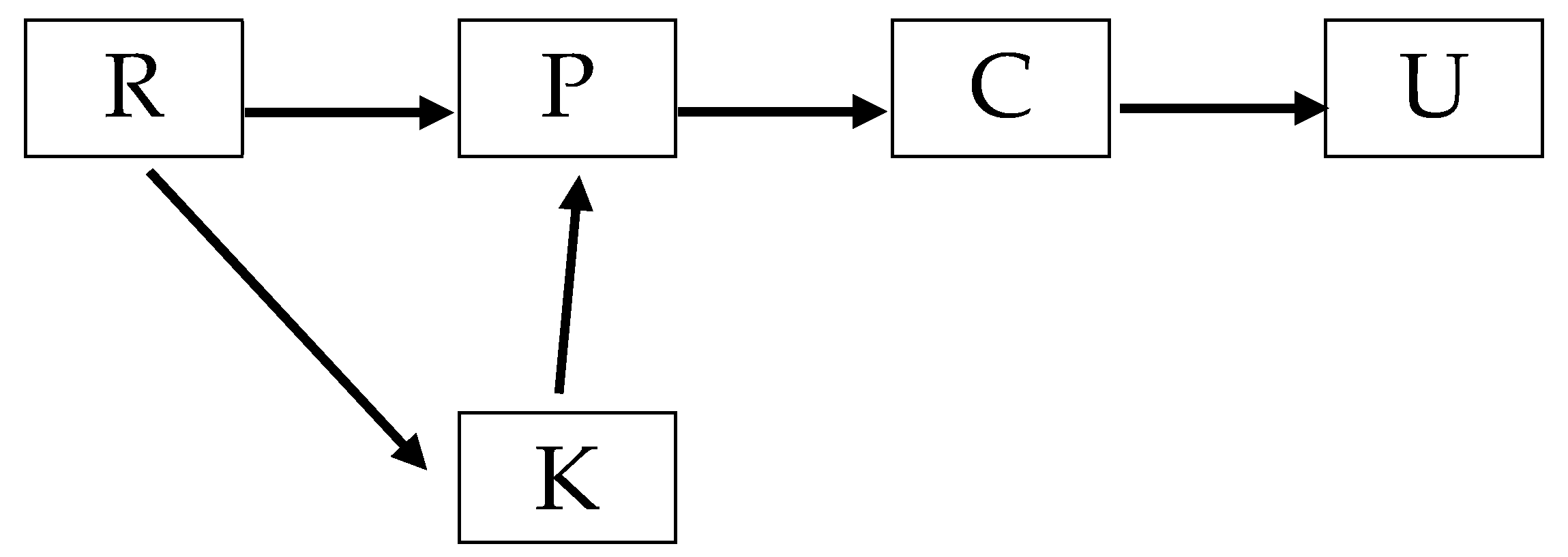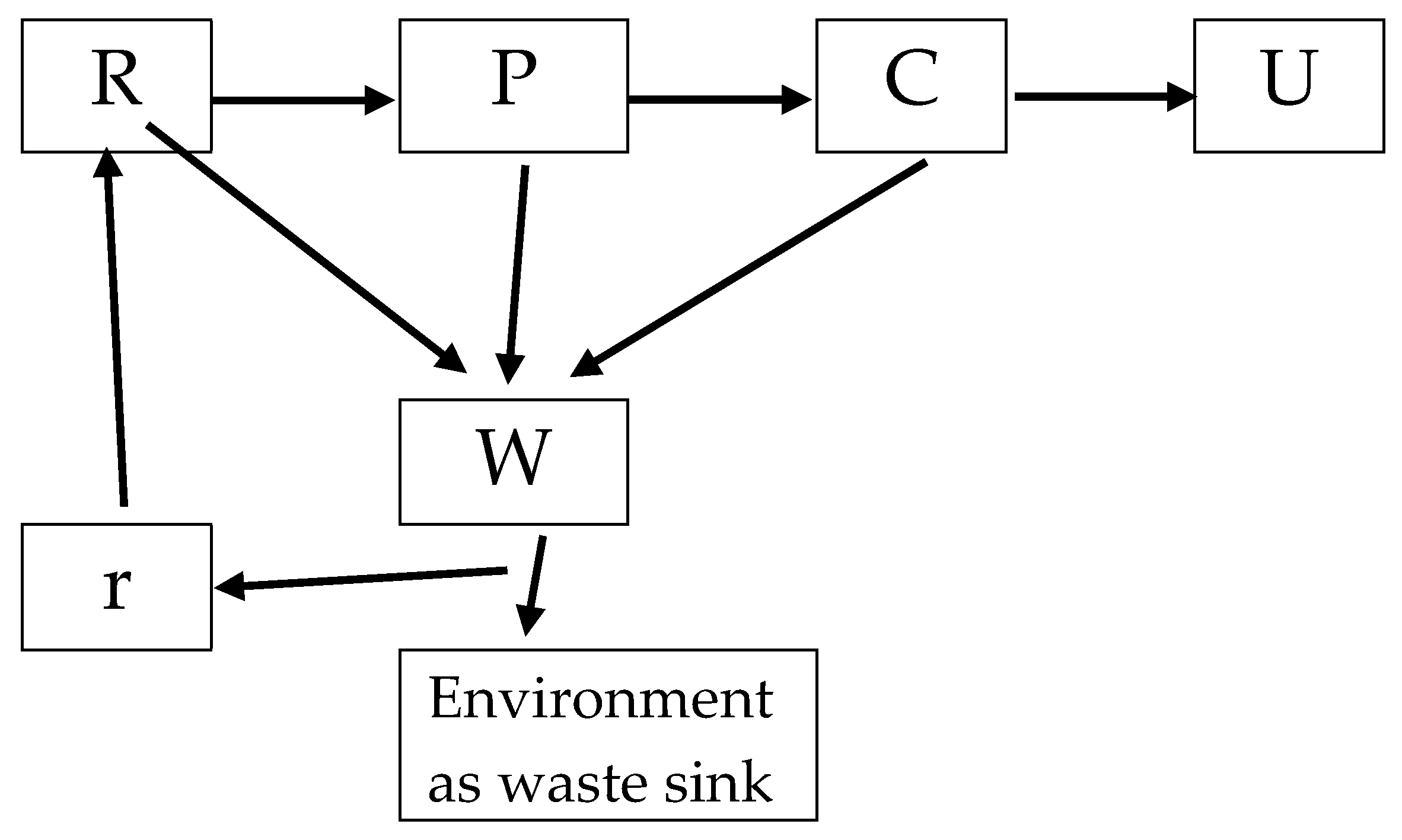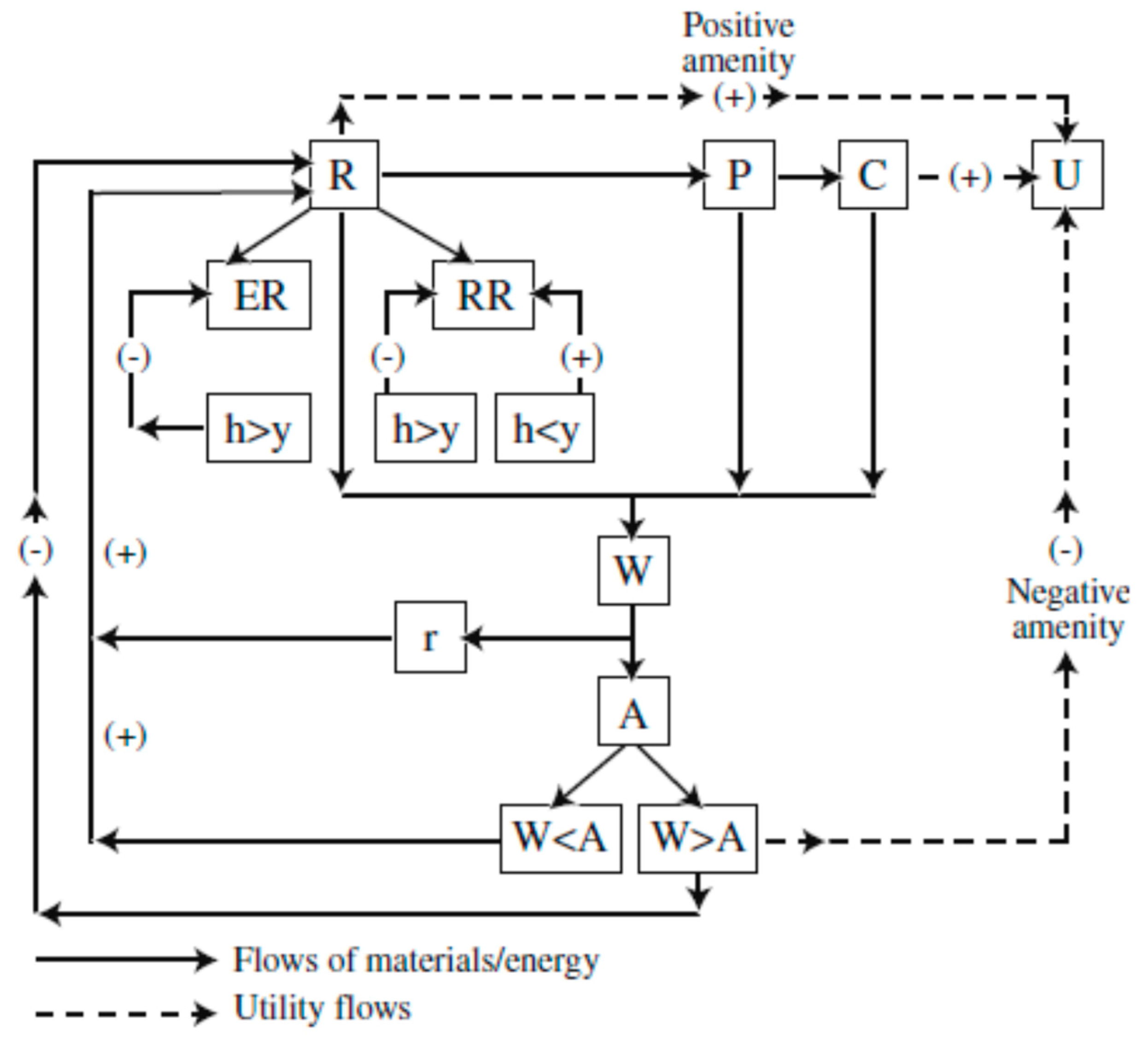1. Introduction
The use of limited-space resources generates multiple concerns for governments as well as for academics in terms of finding the optimal solution to respond to the challenges of climate change or of the growing demand in consumerist economies. Ratifying the Kyoto Protocol and enforcing it in as many countries as possible creates the premise for combating pollution from industrial processes.
Turning linear economies, based on the production–consumption–waste model, into circular economies, regenerative by definition and based on production–consumption–reuse of resources, seems to be the puzzle piece missing from the current structure of the consumption pattern [
1,
2,
3,
4,
5]. Investing in innovative equipment for environmental protection plays an essential role in circular economy.
Beyond the evolution of the classical model of economic growth [
6], Andersen conceptualized an economic growth model to determine the main impact factors, then capitalized on empirical data in an attempt to determine the economic factors that stimulate or inhibit the transition to a circular pattern.
The economic literature of the last ten years abounds in econometric presentations to determine the impact of waste management processes on economic activities in the context of the general equilibrium model [
7,
8,
9,
10].
By way of example, in Sweden, Ljunggren Söderman et al. [
11] analyzed the interconnection of solid waste program management in the context of a general equilibrium model in order to find the right answer to the request of the Swedish Parliament for a percent reduction in the amount of waste in relation to the growth indicator [
12]. It should be mentioned here that Sweden is among those countries with a high degree of waste reuse, being top-ranking among the Member States of the European Union.
The economists Xie and Saltzman [
13] studied the influence on Gross Domestic Product (GDP) of dangerous waste fees for waste resulting from mining activities in South Africa. It should be noted that the two continents Africa and Asia are ranked last in terms of their waste reuse rate, while North America and Europe are at the top of the ranking and amongst the most highly industrialized countries.
The impact of environmental policy on growth prospects has been studied by international organizations such as The Statistical Office of the European Union (OECD) [
14] and by European institutions, for example, the European Commission (EC) [
15]. Strongly industrialized, developed agriculture states are inevitably facing environmental challenges. Keeping the ecosystem is or should be a policy priority, worldwide. The United Nations Environment Program reflects these concerns. A prestigious organization with an invaluable contribution to the evaluation of European environmental policies is the Ellen MacArthur Foundation, created in 2010 to accelerate the transition to a circular economy process. Ellen MacArthur Foundation’s report “Economic Growth—Circular Economy, A Vision on European Competitiveness” [
16] shows that an advanced technology-based circular economy will allow Europe to raise productivity by up to 3 percentage points annually. According to the study, this generates a primary resource benefit of up to €0.6 trillion per year by 2030 compared to Europe’s current economies, resulting in a GDP growth of 7 percentage points over the current scenario development and a positive impact on employment.
The concept of “cradle to cradle” (C2C) was introduced by Mc Donough and Braungart and is specific to a regenerative circular economy [
17]. This concept applies to the process of generating sustainable energy and involves the transformation of waste into new products, the use of natural energy sources, and the diversity of ecosystems [
18]. In contrast to this, Morrison [
19] criticizes the “cradle to grave” formula used in the industrial process, wherein products are transferred to waste, often without the possibility of being reused.
The extent of Chinese economic development over the past two decades is well known. Environmental degradation inevitably resulted in the wake of the economic miracle. Circular economy is thus a strategy for sustainable development and was proposed by the government based in Beijing to improve energy efficiency and material use. This strategy, officially accepted in 2002, was put into practice and developed in pilot areas in China [
20]. National laws and regulations have been adopted to facilitate the implementation of circular economy projects. China has become the first country in the world to provide objective, credible information on the state of implementation of circular economy processes, based on a unique system of indicators for political decision-making. The work of Chinese economists [
21] critically analyzes the applicative model of the circular Chinese economy. Indicators conceived by the Chinese state can be widely used by other states, also aware of the danger of environmental degradation, as a reference point for knowing the stage of development of the circular economy.
The circular economy could be also linked to the sharing economy paradigm [
7]. This approach could be viewed as a closed loop of the flow of materials, instead of the linear “produce–use–dispose” view. Closing the loop through energy recovery or recycling is just a part of the solution to mend the linear economy model. In fact, repair, reuse, or remanufacturing loops are preferred over energy recovery, recycling, or landfilling [
8].
Rapid development of digital technology is the main key that is enabling organizations to profitably scale the business models of a circular economy [
9]. At the point at which a value chain is moving toward circular economy practices, the dynamics of power and competitiveness transform through disruptive technologies such as mobile, analytics, and recycling technology [
10].
The research question addressed here is whether there is a direct and positive relationship between the R&D expenditures for circular economy processes of European Union (EU) countries and their economic efficiencies; we measure this using a composite index.
This paper is structured as follows. In the first part, we present the composite indicator built on Shannon entropy. The resulting weights assigned to each indicator in our analysis measure the significance of each indicator involved in the development of the composite indicator. Then, an entropy-based analysis was conducted for the 28 European Union countries based on an algorithm developed using the composite indicator. A ranking of the EU countries is further revealed, and results are analyzed in the Discussion section.
3. Results
In the EU, there are 28 Member States which joined the EU at different times. In our analysis, we will take as a basis the year 2007, which corresponds to the accession of Romania to the European Union.
The modelling of Circular Economy processes has been analyzed in a number of research articles. It was demonstrated that there is a close link between the use of a cyclical economy and economic growth [
51,
52,
53]. Other authors [
54,
55,
56,
57] concluded that human capital and innovation for environmental benefits have a positive impact on economic growth.
Now, we will use entropy measures to evaluate the circular economy output for the 28 EU countries. The data were collected from The Statistical Office of the European Union (EUROSTAT) and are displayed in
Table 1. For circular economy, we have used the recycling percentage of municipality waste as a proxy, while economic growth was defined as percentage increase in GDP per capita in the member States.
The weights were determined after computing the following steps.
Step 1:
(a) Standardizing the data. The original matrix
was standardized by the formula
(b) Formula
was used to finalize the standardization, where
and
represent the standard deviation and the mean value of the
jth index.
(c) The entropy formula contains a natural logarithm, so the value of the index cannot be negative.
We set
where
d is a number which is greater than the value of
.
This way, we get d = 0.789623.
Table 2 displays the results after performing Step 1.
Step 2:
At this stage, we compute the values of the indices’ weights.
(a) The probabilities of the
jth index of the
ith sample are calculated with the formula
where
, and
.
The final results after applying Step 2 can be seen in
Table 3.
(b) Now, we compute the entropy
, which corresponds to the index
j, by using the formula
Hence, we got the results and .
(c) The utility function which corresponds to the jth index can be calculated with the formula .
This gives us the results and .
(d) Now, we standardize the weights of the
jth indices by using the transformation
Hence, we have obtained the results and .
Step 3:
At this stage, we will evaluate the samples. The value of the
jth indices in the
ith sample are given by the formula
Hence, the total value corresponding to the
ith sample is given by the formula
In
Table 4 are displayed the results obtained by performing Step 3.
Now, by running the data through the four steps of the above algorithm, we get the ranking of the countries. The results are displayed in decreasing order in
Table 5. The first ranked country has the highest score.
An investment indicator is computed as the government 10-year average investment in R&D for Circular Economy. The Efficiency Index is calculated for all EU countries as the ratio between the outcome we presented in
Table 5 and the Investment Index [
58,
59,
60]. The results can be seen in
Table 6.
The rankings above display interesting results: countries with higher expenditures on R&D for Circular Economy have higher efficiency scores. At the same time, countries with a higher level of Circular Economy percentage use have a higher efficiency index.
4. Discussion and Conclusions
The European Commission Report on environmental policy indicates some reuse of resources in EU countries. Implementation of circular economy processes requires significant investments in environmental infrastructure in order for member states to develop smoothly towards meeting their environmental objectives [
61,
62].
Shortcomings are observed in the productivity of resources and labor employed in the field of environmental protection. Beyond inventory of the current situation of the circular economy, the paper presents the advantages of using the conceptual model in terms of sustainable economic growth based on the efficient and responsible consumption of resources.
Studies on developed economies have shown multiple benefits based on educating the civil society on environmental protection while making investments in infrastructure for collection, sorting, and recycling [
63]. The positive effects of circular economy processes commensurately increase the level of municipal revenues, labor employed, and the profit earned by entrepreneurs providing environmental infrastructure [
8].
Probably the most important benefit of using a circular economy process is felt individually. Forming an analogy between the lives of products (through reuse or extending the product’s life) and the human life, one can observe how environmental factors are propagated in the quality of our daily life.
The results which were obtained from our analysis confirm those in the economic literature [
64,
65] that the processes associated with the circular economy have positive effects on economic growth and resource productivity and are in line with the European target of increasing resource productivity by 30% before 2030, which may lead to a GDP growth of almost 1 percentage point [
13]. This study may also be important for regional, local, and national public authorities which are involved in writing the legislative background, as well as for enterprises that can establish their business plans according to what the circular economy’s expected effects may be on implementation for every member state.
In addition, the present study highlights a straightforward, reliable, and practical instrument for assessing an efficiency index for circular economy output using a composite index. It should be noted that when the ratio of the outcome value obtained using an entropy measure and the mean value for the corresponding ten years’ time span of Research & Development expenditure for Circular Economy processes for every country is computed, the results indicate that countries with higher levels of investment in circular economy processes are more efficient.
As was mentioned in the introductory part, the research direction was prompted by the increased interest in research evaluation of the circular economy and processes at the EU level. The rankings based on entropy analysis displayed in
Table 6 are similar to the rankings available at the international level, which validates our entropy analysis as an efficient tool. The findings are in line with those of other studies in this area [
66,
67], showing significant and consistent results when different sets of data are analyzed.
Since the macroeconomic indicators from the analysis concerned a period of ten years, one of the main limitations of this research is related to the time database used for the factor analysis. Another limitation is related to the availability of the data and the time frame.
Future research will be conducted for longer periods of time which may provide a more accurate picture of the circular economy processes at the EU level. Besides adding to the data sets to be analyzed using information measures, further research also needs to investigate what types of entropy measures are more liable to result in more well-rounded and dependable findings. This study was based on a composite index modeled by Shannon entropy; hence, future studies could try to model the circular economy processes using other entropy measures. Last, but not least, future analysis could extend this research to countries elsewhere in Europe or worldwide.









